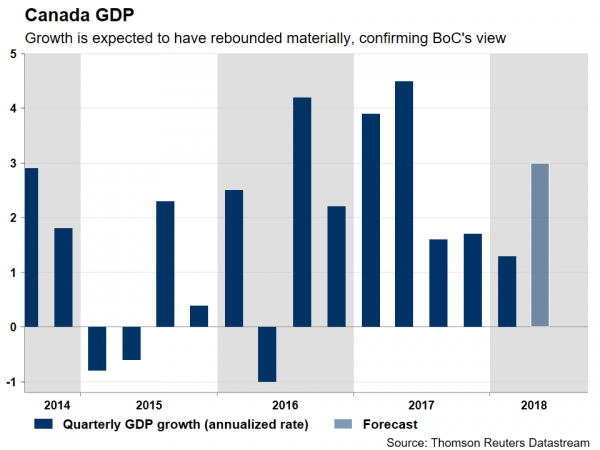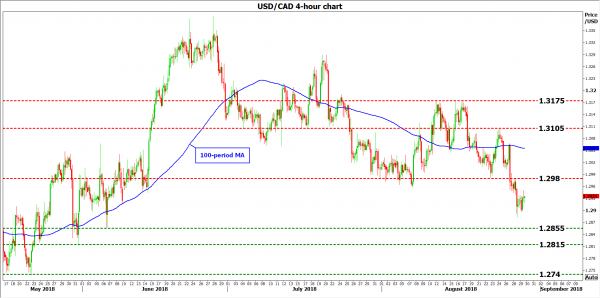Canada’s GDP data for Q2 are slated for release on Thursday, at 1230 GMT. Forecasts point to a material rebound in economic growth, which is likely to be pleasant news for BoC policymakers, and could support the loonie somewhat. That said, the most crucial determinant of the currency’s forthcoming direction may be how the US-Canada trade negotiations play out over the coming days.
The Canadian economy experienced a soft patch in the first quarter of the year, recording a mere 1.3% annualized GDP growth rate during that period amid a slowdown in the housing market and weakness in exports. That said, the Bank of Canada (BoC) has repeatedly stated that it anticipates this softness to have been temporary and economic growth to rebound in the second quarter. Indeed, the nation’s upcoming GDP data are forecast to confirm that, by showing growth clocking in at a robust 3.0% annualized rate in Q2.
Looking at market pricing, investors have fully priced in one more quarter-point rate increase by the BoC before year-end, while they also assign a 25% probability for a second one, according to Canada’s overnight index swaps. In the more immediate term, the next BoC policy decision is on September 5, and markets currently assign a 43% likelihood for a hike as early as then. With the nation’s unemployment rate hovering at four-decade lows and inflation steadily creeping higher, a strong GDP print for Q2 could well amplify speculation that the Bank may act as early as at the September meeting, and thereby bring the loonie under renewed buying interest.
That said, a far larger determinant of the currency’s forthcoming direction – at least in the short run – may be how, and at what speed, the NAFTA negotiations progress from here. The US and Mexico reached a preliminary accord earlier this week, allowing Canada to now re-engage in the talks to flesh out a trilateral deal. Should there be clear signs that a “full-blown” agreement is close to being completed, that would likely cause the NAFTA risk premium on the loonie to fade, triggering a relief rally. Not to mention such an outcome could also make the BoC more confident in raising rates, as one of the biggest risks to the economy would disappear. The opposite holds true as well, of course. To specify, any hints that the negotiations are likely to drag on for a prolonged period amid disagreements could come as a disappointment for investors anticipating a near-term deal, and may trigger a negative reaction in the loonie.
Technically, looking at dollar/loonie, support to declines may come around the 1.2855 zone, marked by the pair’s June 6 low. A downside break could open the door for the 1.2815 hurdle, this being the May 31 trough, before the May 22 low of 1.2740 comes into view.
On the other hand, in case of advances, initial resistance may be found near 1.2980, defined by the inside swing low on August 22. If the bulls pierce above it, the attention would increasingly shift to the 1.3105 mark, identified by the August 24 peak. Even higher, advances may stall near the 1.3175 territory, which halted the pair’s surge twice in mid-August.














